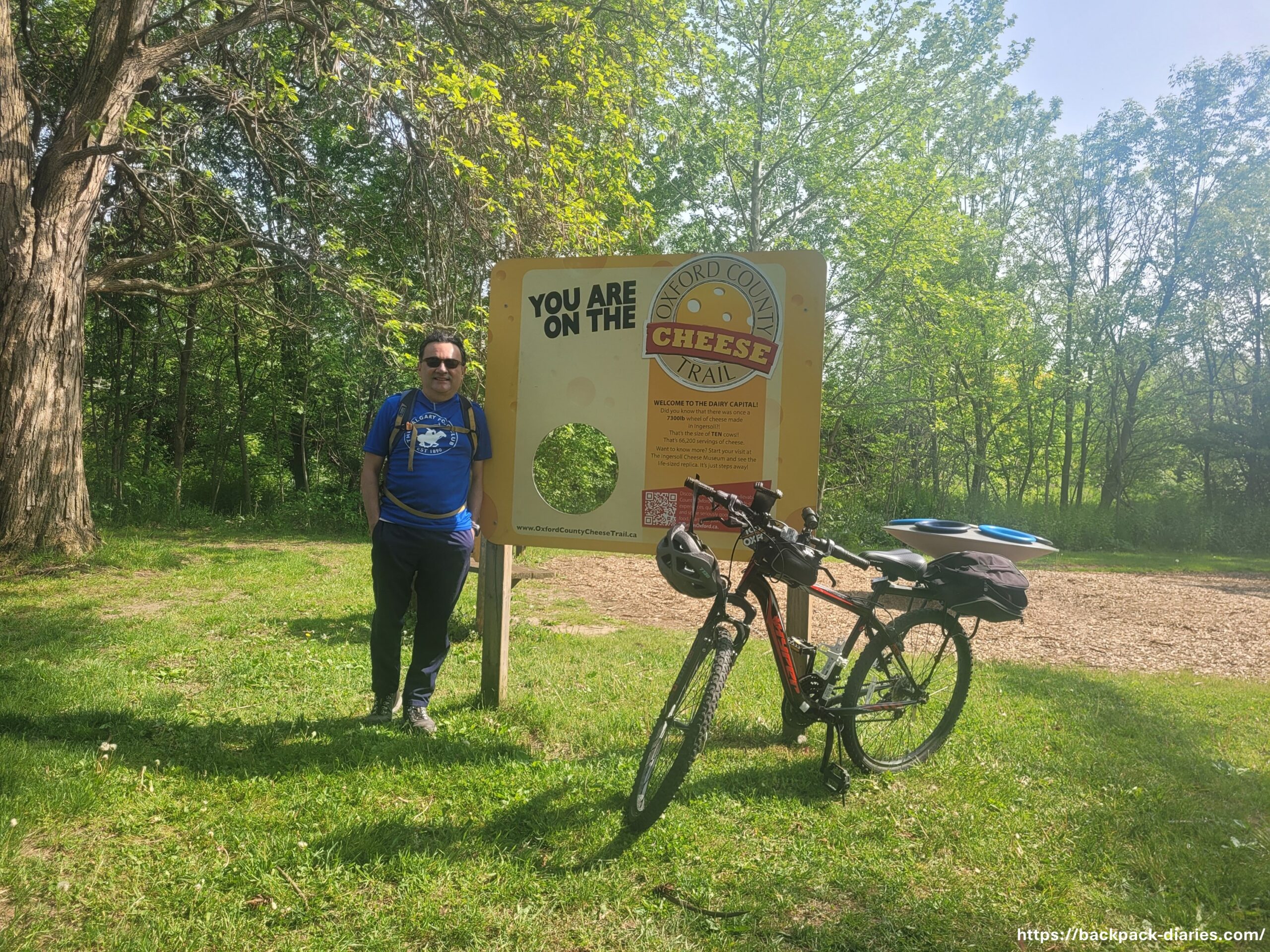This is the second part of my tour along the cheese trail in Oxford County Ontario, Canada. In the first part of the series, I visited some of the spots along the Cheese trail in Tillsonburg and Ingersoll. This blogpost now covers Woodstock.
Woodstock
Woodstock is the largest city in Oxford County, with a population of around 40,000.
It is about halfway between London and Kitchener-Waterloo. Although the dairy industry in Woodstock has diversified over the years, it remains an important driver of the county’s economy.

Although it was a short visit to Woodstock, I stopped by the statue in honour of the “Springbank Snow Countess.
Who was the Countess?
The “Springbank Snow Countess” was a famous Canadian Holstein cow known for her record milk production. She was the world champion in lifetime butterfat production, producing 9062 lbs of butterfat and 207,505 lbs in 10 lactations in 1936. Her accomplishments made her a celebrated figure in the Canadian dairy industry.

However, as in the Olympics, records are meant to be broken. Decades later, “Snowball Sylvia Alcartra” surpassed Countess’s records in 1954, followed by “Montvic Colleen Abbekerk” in 1956.
Despite her records being surpassed, the Countess’s legacy continues to inspire future generations of breeders and farmers here in Woodstock and the Canadian dairy industry.
Guns Hill artisan craft factory
Gunn’s Hill Artisan Cheese is situated to the south of Woodstock on Gunn’s Hill Road. Shep Ysselstein and Colleen Bator have been making cheese for over a decade at Gunn’s Hill Artisan Cheese. They specialize in hand-crafted Swiss-style cheese made with milk from their family farm.

Guided tours
Guided tours to learn a bit about the cheese-making process are offered at Gunn’s Hill and can be booked online in advance. During the tour, Shep himself conducts and explains a bit about the company’s history and how he learned to make cheese in the town of Handeck, Switzerland.

The tour starts at the receiving bay, where milk is received from the barns across the farm.
Gunn’s Hill produces between 3000 and 3500 litres of milk daily, with 100 cows producing 30 litres of milk each day. Most of their cows are Holsteins, which are also the most common breed in Ontario, accounting for 93% of cows in the region. However, they also produce cheese for other regional farmers who raise goats, sheep, and buffalos.

Prior to my visit, I had not heard about buffalo milk. This triggered my curiosity enough for me to plan to purchase a wedge solely to try it.
As our tour continued, we entered the production area. Shep showed us the four stainless steel containers called “cheese vats.”

Coincidentally, earlier in the day, I encountered an antique cheese vat during my visit to the Cheese Factory Museum in Ingersoll. The vats here have capacities ranging from the largest at 4000 litres to the smallest at 400 litres. They are used during the initial production stages: heating and curdling the milk and cutting and stirring the curds.
The Aging Room
During the aging process of cheese, it is placed in a room specially designed for the purpose, known as the “aging room.” Shep asked while in the aging room and to be prepared for a slightly colder temperature and a strong smell caused by the cheese and bacteria in the aging process.

Generally, the longer the aging, the stronger the flavour. This aging process made me recall my “Tequila experience at the Latin America’s Oldest Distillery (1758)”
One of their cheeses is “Five Brothers,” which usually undergoes an 8-month aging process. Hence, the ones that were prepared during my visit in August were to be on the counter about next February.
The Handeck, another of their landmark cheeses, is aged between a year and a year and a half.

Other than Cheddar, cheeses are aged up to 2 years. Cheddar is unique because it is aged at cold temperatures and takes longer to develop its flavour.
Shep commented that he had tasted a 14-year-old cheese, time enough for a cheese to have peaked its strongest flavor.
We made a last stop at the packaging station before the tasting session.

Cheese tasting session
At the end of the facilities tour, Sheps presented a tray of cheeses and curds for the tasting session;

We first tried the Five Brothers, the company’s landmark cheese. It is a distinctive variety known as Appenzeller from northern Switzerland. It is a cheese of creamy texture and good for pairing with white wines like Chardonnay, Sauvignon Blanc, and Pilsner beers.

Next in our tasting experience was Handeck, an artisanal milk cheese crafted using traditional methods reminiscent of Swiss mountain-style cheeses. Since it is more than a year of aging, this cheese has infused the essence of the cedar wood planks. It had a drier texture but more complex flavours.

Next, we tasted Brigid’s Brie. Brie is a type of cheese with a white, soft surface and creamy ripened cheese aged only 6 weeks.
Buffalo Bliss is another brie that I wanted to try.It is made from Buffalo milk from the Amish community of Aylmer, Ontario, not far from here.
We tried some fresh curds and then the last one was the “Dark Side of the Moo.” This hand-crafted cow’s milk cheese is modelled after a little-known Swiss cheese called Mutchli. During the preparation process it is soaked in Dark Side Chocolate Stout for four days and then aged for four months.

At the end of my visit, I purchased three wedges of cheese: Handeck, Five Brothers, and Buffalo Brie.
Mountainoak House

Mountainoak is a dairy factory specialized in Gouda cheese. It is located in Blandford-Blenheim, north of Oxford County. The dairy factory is owned by Adam and Hannie Van Bergeik who moved to Canada from Holland in 1996, bringing their expertise in Gouda cheese making. Initially, they only produced cheese for personal consumption but decided to start selling their cheese in 2012. As of five years later, in 2017, they made 1500 kilograms of Gouda cheese, using milk from their 240 Holstein cows.
Guided tour
Mountainoak offers guided tours for a CAD 15 fee. Our guide was a lady who walked us through the different phases and equipment of the process. She showed us the cheese vats, drain tables, cheese presses and packing equipment.

The Aging Room
After touring the process area, we went into the aging room, a cool, controlled-temperature, spacious chamber.
An intense smell of the aging cheeses surrounds the atmosphere of racks of cheese wheels in contrasting hues of black and yellow.

Before the tasting session, we made a quick stop at the packaging station.

Cheese tasting session
Adam, the owner, and Greg, one of his coworkers, presented a selection of cheeses for us to sample.

We started with the farmstead-aged goudas. The first one was the “mild” which had been aged for 2 – 3 months, had a smooth and creamy texture.

The second one was the two-year farmstead, which had a drier texture and was a salty but creamy cheese. Another sample was the three-year aged, which was way drier, more like a parmesan cheese that we usually grate into salads. Unfortunately, the GOLD cheese, which is a highly acclaimed cheese from Mountainoak and has won numerous awards, was not available for tasting that day.
Flavoured Gouda Cheeses
Moving into flavoured gouda cheeses, I particularly enjoyed the “cumin-aged Gouda.” Its flavour was more robust due to the combination of aging and cumin.

The tasting continued with other flavoured goudas, such as toasted onion, black pepper, and wild medal, showcasing herb infusions and proving to be among the favourites.
Two exceptional cheeses stood out: the chili pepper smoked Gouda, which had a creamy texture with natural smokiness, and the black truffle Gouda, which was renowned for its uniquely aromatic flavor that is often reserved for special occasions. The black truffle Gouda stands as a gourmet delight, appealing to discerning palates and connoisseurs of fine cuisine.
What is “quark”?
Quark is a cream cheese with a smooth, creamy, and spreadable texture. A cross between a cream and a yogurt. It is made using natural fermented milk and is quite popular in Europe, where, in some countries, it is known as “flat cheese.” The plain version of quark contains three simple ingredients: pasteurized whole milk, bacterial culture, and rennet.
Adam offered me a sample of maple quark, which I found delicious. Its taste resembled yogurt with honey, but Adam explained that it had less sugar than yogurt.

Before leaving, I purchased two wedges of quark – the Gold and the Black Truffle.
It was Sunday afternoon, and there was no more time to continue with the rest of the spots on the itinerary map. Nevertheless, after this trip, I do feel a bit more knowledgeable about cheeses.
If you haven’t read the first part of this blogpost, here is the link.
Thank you for taking the time to read this post. I appreciate your opinions, comments, likes, and shares.
If you find this post interesting, please feel free to share it or follow my Facebook or Instagram page.
I also invite you to read the previous post “Selena Quintanilla’s legacy in Corpus Christi: My visit to the Museum, Memorial and Her Final Resting Place”
Thank you and have a great day!
E.O.








